Nursing Care Plan for Patient with Breathing Diseases
VerifiedAdded on 2020/10/22
|12
|2931
|493
AI Summary
The assignment is a comprehensive case study that depicts the entire planning process for a patient with breathing diseases. It includes providing post-operative education to Kelly as well as being aware of potential complications that the nurse and patient should be informed of. The report references various books, journals, and online resources related to nursing care and respiratory issues.
Contribute Materials
Your contribution can guide someone’s learning journey. Share your
documents today.
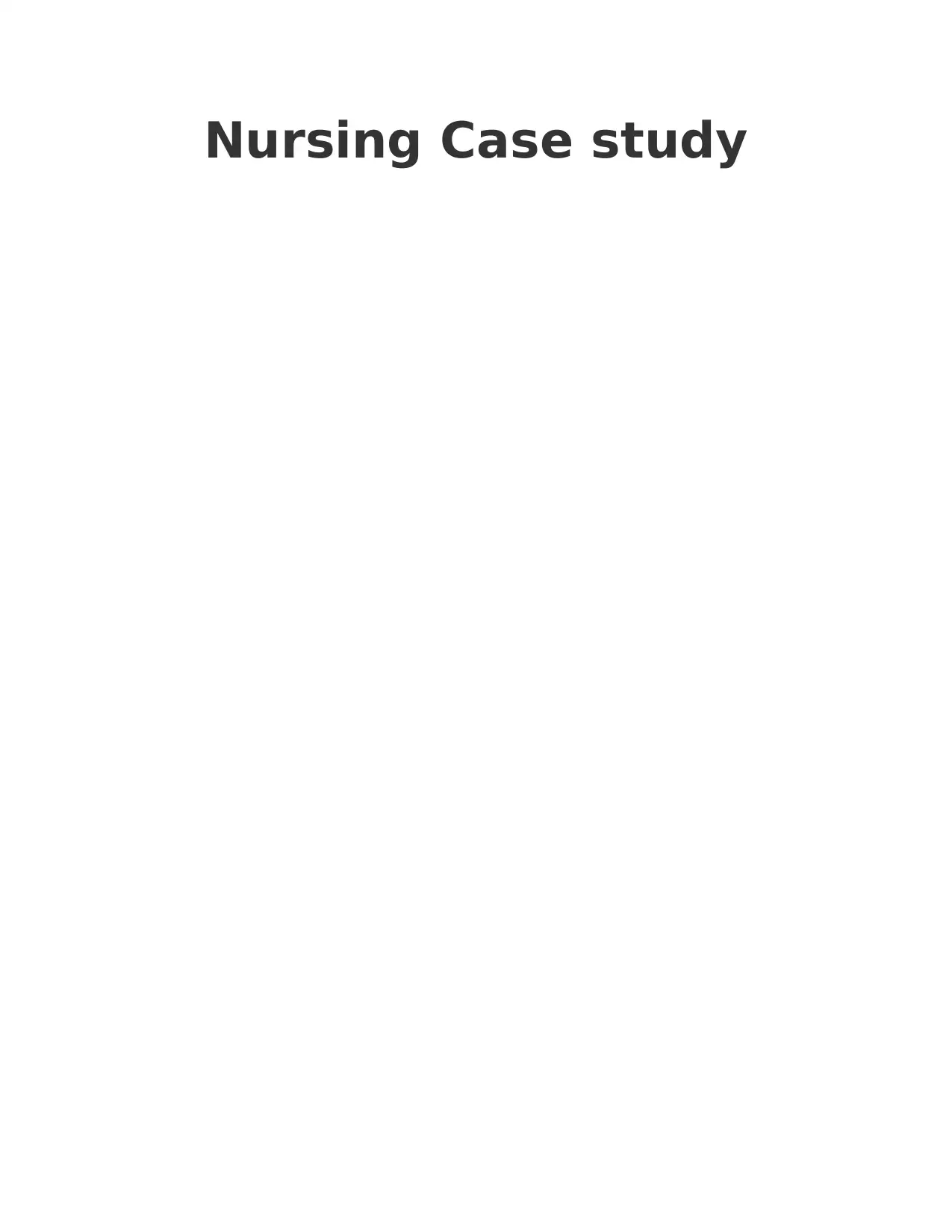
Nursing Case study
Secure Best Marks with AI Grader
Need help grading? Try our AI Grader for instant feedback on your assignments.
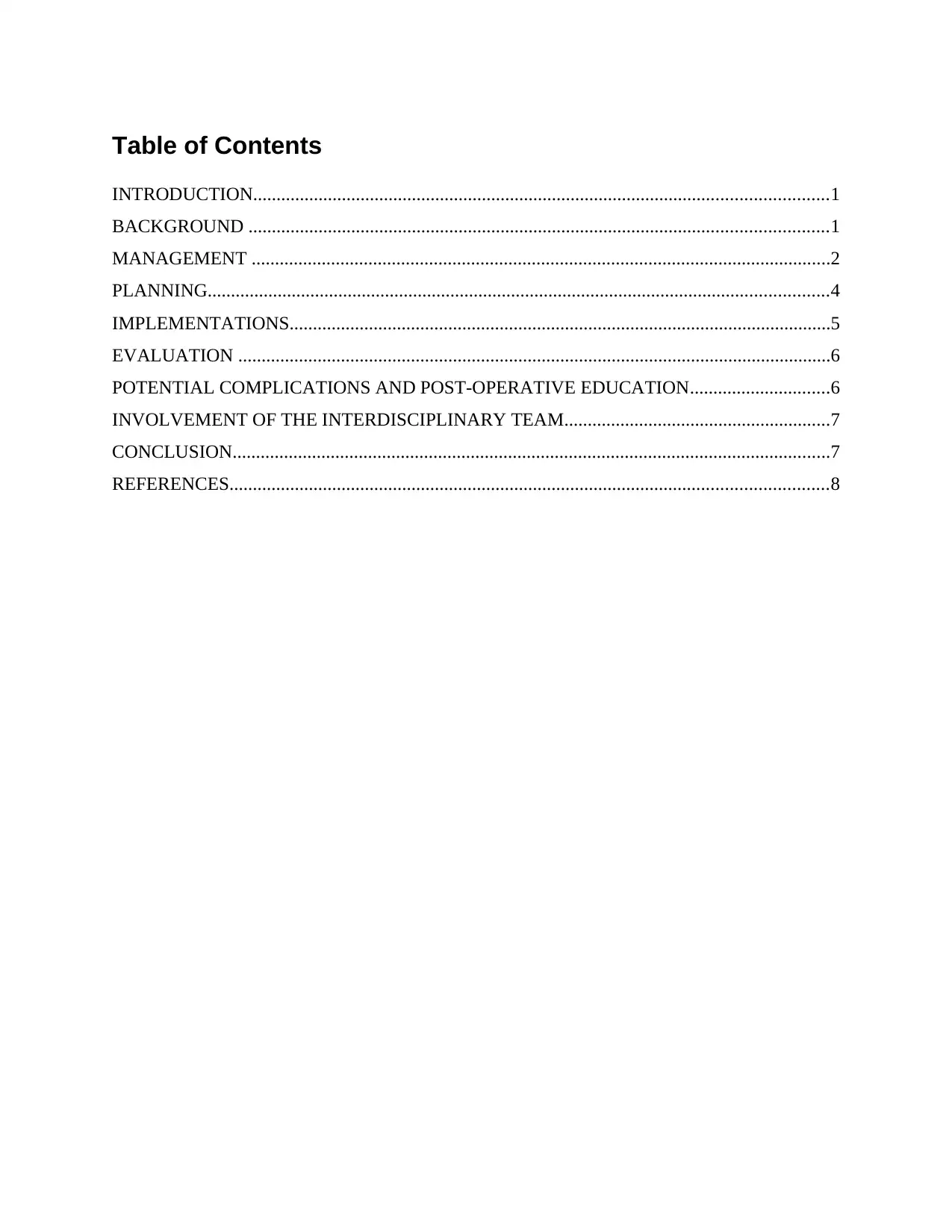
Table of Contents
INTRODUCTION...........................................................................................................................1
BACKGROUND ............................................................................................................................1
MANAGEMENT ............................................................................................................................2
PLANNING.....................................................................................................................................4
IMPLEMENTATIONS....................................................................................................................5
EVALUATION ...............................................................................................................................6
POTENTIAL COMPLICATIONS AND POST-OPERATIVE EDUCATION..............................6
INVOLVEMENT OF THE INTERDISCIPLINARY TEAM.........................................................7
CONCLUSION................................................................................................................................7
REFERENCES................................................................................................................................8
INTRODUCTION...........................................................................................................................1
BACKGROUND ............................................................................................................................1
MANAGEMENT ............................................................................................................................2
PLANNING.....................................................................................................................................4
IMPLEMENTATIONS....................................................................................................................5
EVALUATION ...............................................................................................................................6
POTENTIAL COMPLICATIONS AND POST-OPERATIVE EDUCATION..............................6
INVOLVEMENT OF THE INTERDISCIPLINARY TEAM.........................................................7
CONCLUSION................................................................................................................................7
REFERENCES................................................................................................................................8

INTRODUCTION
Breathing is a most important function of a human body, there are various reasons which
causes problems in breathing. Many people feel difficult to breath when they get cough and cold.
On the other hand, some people have issues due to acute sinusitis. Sinusitis is a major reason of
breathing issue as it causes inflammation in the nose due to which patient suffer for weeks until
the inflammation and the sinus starts draining. The present report is in context to a case study of
Kylie Melville, a 47-year-old lady who is facing acute problem in breathing through nose which
also disrupts her sleep. The report will focus on two main diagnosis and management of nursing
processes to give proper care to the patient.
BACKGROUND
ISOBAR Handover
Identification
1. Patient name – Kylie Melville
2. Age – 47
3. Nurse – xyz, post-operative ward.
Situation
1. Low oxygen level
2. Sensitivity to codeine
3. Low blood pressure
4. Surgery for septoplasty and right ethmoidectomy
Observation
1. Cannot get enough air in and therefore has to breath from mouth
2. Preoperative observations were T-36 7-degree C, HR-74bpm, BP-121/71 mmHg, 02-
94% RA, RR-18pm (Low level of Oxygen)
3. Post-operative observation was T-36 1 degree C, HR-75bpm, RR-19pm, mmHg, 02-
91% RA and pain score 2/10. BP-107/70(Low blood pressure)
Background
1. Kylie has a problem of improper breathing through her nose which disrupts her sleep.
2. Not able to get enough air during exercise and has to breathe through mouth(Vryonides
and et.al., 2017).She has a history of sensitivity to codeine which causes dizziness,
nausea, etc. Using breathing techniques such as slow breaths in order to stabilize
Breathing is a most important function of a human body, there are various reasons which
causes problems in breathing. Many people feel difficult to breath when they get cough and cold.
On the other hand, some people have issues due to acute sinusitis. Sinusitis is a major reason of
breathing issue as it causes inflammation in the nose due to which patient suffer for weeks until
the inflammation and the sinus starts draining. The present report is in context to a case study of
Kylie Melville, a 47-year-old lady who is facing acute problem in breathing through nose which
also disrupts her sleep. The report will focus on two main diagnosis and management of nursing
processes to give proper care to the patient.
BACKGROUND
ISOBAR Handover
Identification
1. Patient name – Kylie Melville
2. Age – 47
3. Nurse – xyz, post-operative ward.
Situation
1. Low oxygen level
2. Sensitivity to codeine
3. Low blood pressure
4. Surgery for septoplasty and right ethmoidectomy
Observation
1. Cannot get enough air in and therefore has to breath from mouth
2. Preoperative observations were T-36 7-degree C, HR-74bpm, BP-121/71 mmHg, 02-
94% RA, RR-18pm (Low level of Oxygen)
3. Post-operative observation was T-36 1 degree C, HR-75bpm, RR-19pm, mmHg, 02-
91% RA and pain score 2/10. BP-107/70(Low blood pressure)
Background
1. Kylie has a problem of improper breathing through her nose which disrupts her sleep.
2. Not able to get enough air during exercise and has to breathe through mouth(Vryonides
and et.al., 2017).She has a history of sensitivity to codeine which causes dizziness,
nausea, etc. Using breathing techniques such as slow breaths in order to stabilize
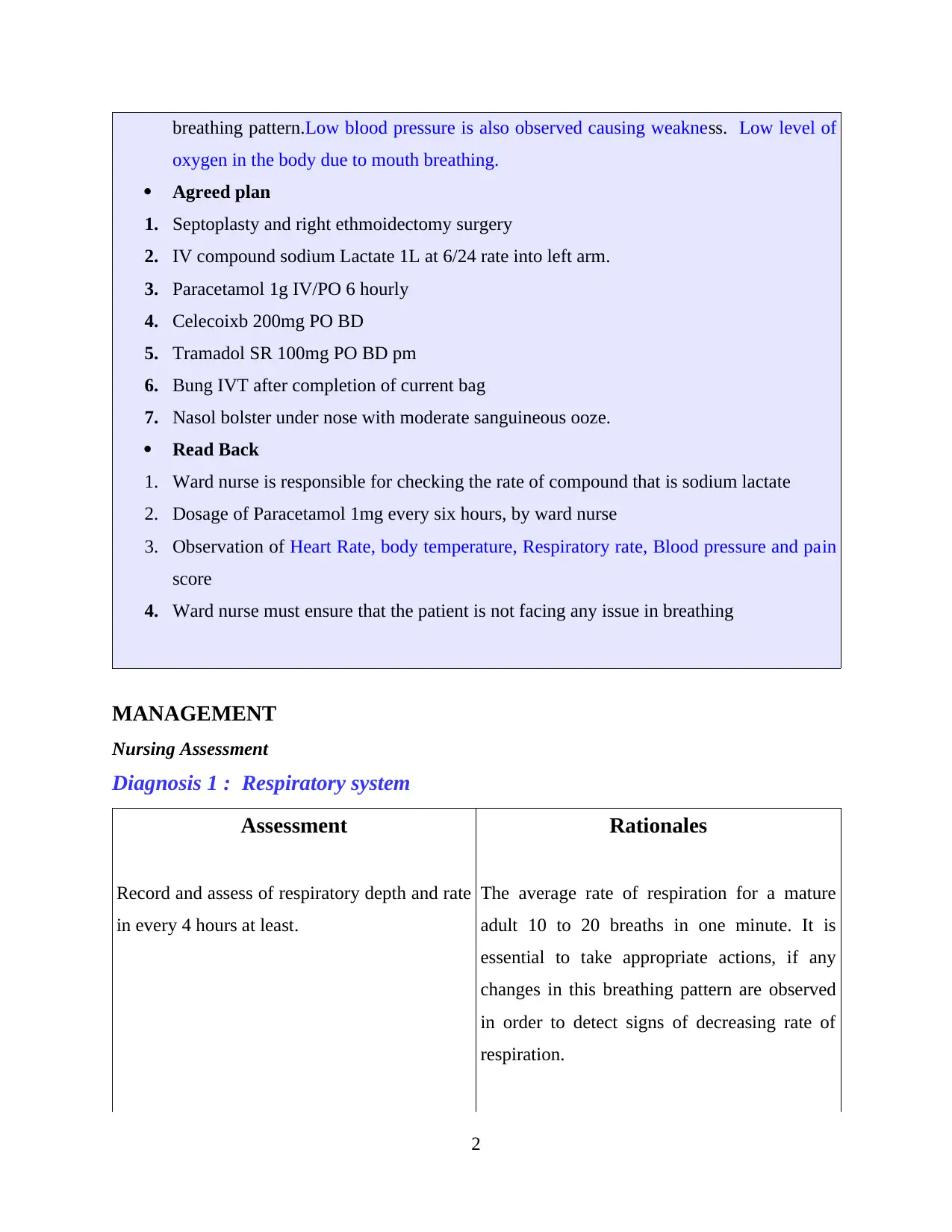
breathing pattern.Low blood pressure is also observed causing weakness. Low level of
oxygen in the body due to mouth breathing.
Agreed plan
1. Septoplasty and right ethmoidectomy surgery
2. IV compound sodium Lactate 1L at 6/24 rate into left arm.
3. Paracetamol 1g IV/PO 6 hourly
4. Celecoixb 200mg PO BD
5. Tramadol SR 100mg PO BD pm
6. Bung IVT after completion of current bag
7. Nasol bolster under nose with moderate sanguineous ooze.
Read Back
1. Ward nurse is responsible for checking the rate of compound that is sodium lactate
2. Dosage of Paracetamol 1mg every six hours, by ward nurse
3. Observation of Heart Rate, body temperature, Respiratory rate, Blood pressure and pain
score
4. Ward nurse must ensure that the patient is not facing any issue in breathing
MANAGEMENT
Nursing Assessment
Diagnosis 1 : Respiratory system
Assessment
Record and assess of respiratory depth and rate
in every 4 hours at least.
Rationales
The average rate of respiration for a mature
adult 10 to 20 breaths in one minute. It is
essential to take appropriate actions, if any
changes in this breathing pattern are observed
in order to detect signs of decreasing rate of
respiration.
2
oxygen in the body due to mouth breathing.
Agreed plan
1. Septoplasty and right ethmoidectomy surgery
2. IV compound sodium Lactate 1L at 6/24 rate into left arm.
3. Paracetamol 1g IV/PO 6 hourly
4. Celecoixb 200mg PO BD
5. Tramadol SR 100mg PO BD pm
6. Bung IVT after completion of current bag
7. Nasol bolster under nose with moderate sanguineous ooze.
Read Back
1. Ward nurse is responsible for checking the rate of compound that is sodium lactate
2. Dosage of Paracetamol 1mg every six hours, by ward nurse
3. Observation of Heart Rate, body temperature, Respiratory rate, Blood pressure and pain
score
4. Ward nurse must ensure that the patient is not facing any issue in breathing
MANAGEMENT
Nursing Assessment
Diagnosis 1 : Respiratory system
Assessment
Record and assess of respiratory depth and rate
in every 4 hours at least.
Rationales
The average rate of respiration for a mature
adult 10 to 20 breaths in one minute. It is
essential to take appropriate actions, if any
changes in this breathing pattern are observed
in order to detect signs of decreasing rate of
respiration.
2
Secure Best Marks with AI Grader
Need help grading? Try our AI Grader for instant feedback on your assignments.
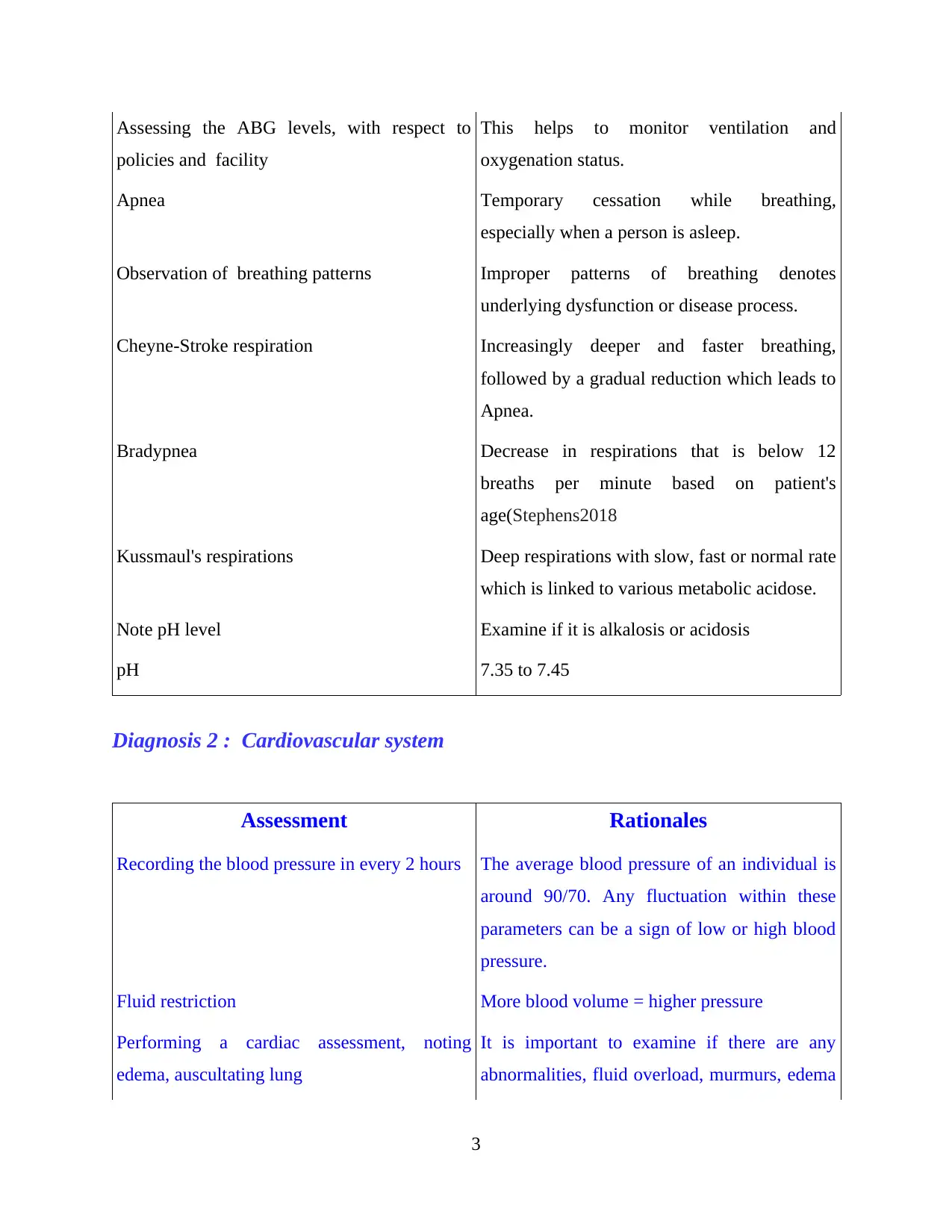
Assessing the ABG levels, with respect to
policies and facility
This helps to monitor ventilation and
oxygenation status.
Apnea Temporary cessation while breathing,
especially when a person is asleep.
Observation of breathing patterns Improper patterns of breathing denotes
underlying dysfunction or disease process.
Cheyne-Stroke respiration Increasingly deeper and faster breathing,
followed by a gradual reduction which leads to
Apnea.
Bradypnea Decrease in respirations that is below 12
breaths per minute based on patient's
age(Stephens2018
Kussmaul's respirations Deep respirations with slow, fast or normal rate
which is linked to various metabolic acidose.
Note pH level Examine if it is alkalosis or acidosis
pH 7.35 to 7.45
Diagnosis 2 : Cardiovascular system
Assessment Rationales
Recording the blood pressure in every 2 hours The average blood pressure of an individual is
around 90/70. Any fluctuation within these
parameters can be a sign of low or high blood
pressure.
Fluid restriction More blood volume = higher pressure
Performing a cardiac assessment, noting
edema, auscultating lung
It is important to examine if there are any
abnormalities, fluid overload, murmurs, edema
3
policies and facility
This helps to monitor ventilation and
oxygenation status.
Apnea Temporary cessation while breathing,
especially when a person is asleep.
Observation of breathing patterns Improper patterns of breathing denotes
underlying dysfunction or disease process.
Cheyne-Stroke respiration Increasingly deeper and faster breathing,
followed by a gradual reduction which leads to
Apnea.
Bradypnea Decrease in respirations that is below 12
breaths per minute based on patient's
age(Stephens2018
Kussmaul's respirations Deep respirations with slow, fast or normal rate
which is linked to various metabolic acidose.
Note pH level Examine if it is alkalosis or acidosis
pH 7.35 to 7.45
Diagnosis 2 : Cardiovascular system
Assessment Rationales
Recording the blood pressure in every 2 hours The average blood pressure of an individual is
around 90/70. Any fluctuation within these
parameters can be a sign of low or high blood
pressure.
Fluid restriction More blood volume = higher pressure
Performing a cardiac assessment, noting
edema, auscultating lung
It is important to examine if there are any
abnormalities, fluid overload, murmurs, edema
3
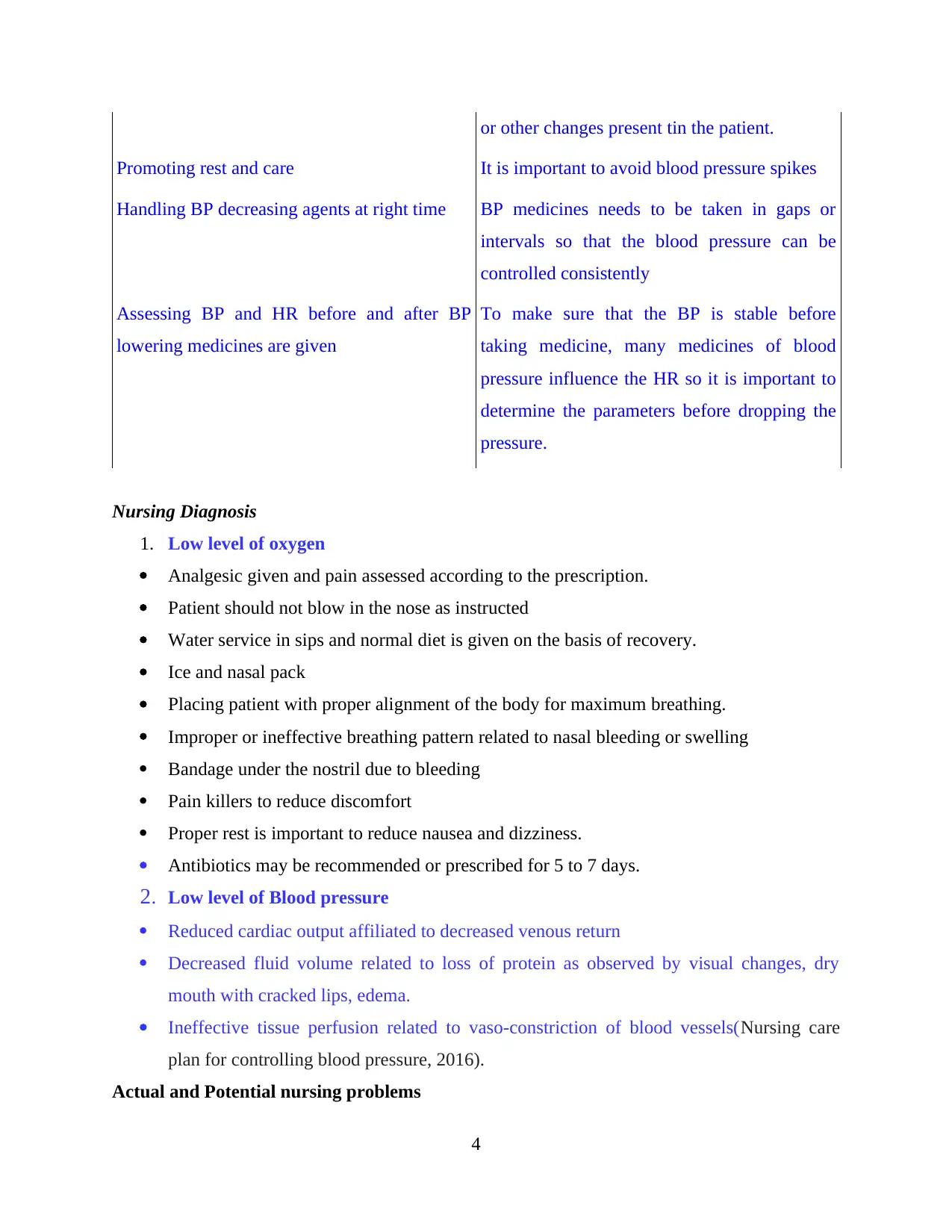
or other changes present tin the patient.
Promoting rest and care It is important to avoid blood pressure spikes
Handling BP decreasing agents at right time BP medicines needs to be taken in gaps or
intervals so that the blood pressure can be
controlled consistently
Assessing BP and HR before and after BP
lowering medicines are given
To make sure that the BP is stable before
taking medicine, many medicines of blood
pressure influence the HR so it is important to
determine the parameters before dropping the
pressure.
Nursing Diagnosis
1. Low level of oxygen
Analgesic given and pain assessed according to the prescription.
Patient should not blow in the nose as instructed
Water service in sips and normal diet is given on the basis of recovery.
Ice and nasal pack
Placing patient with proper alignment of the body for maximum breathing.
Improper or ineffective breathing pattern related to nasal bleeding or swelling
Bandage under the nostril due to bleeding
Pain killers to reduce discomfort
Proper rest is important to reduce nausea and dizziness.
Antibiotics may be recommended or prescribed for 5 to 7 days.
2. Low level of Blood pressure
Reduced cardiac output affiliated to decreased venous return
Decreased fluid volume related to loss of protein as observed by visual changes, dry
mouth with cracked lips, edema.
Ineffective tissue perfusion related to vaso-constriction of blood vessels(Nursing care
plan for controlling blood pressure, 2016).
Actual and Potential nursing problems
4
Promoting rest and care It is important to avoid blood pressure spikes
Handling BP decreasing agents at right time BP medicines needs to be taken in gaps or
intervals so that the blood pressure can be
controlled consistently
Assessing BP and HR before and after BP
lowering medicines are given
To make sure that the BP is stable before
taking medicine, many medicines of blood
pressure influence the HR so it is important to
determine the parameters before dropping the
pressure.
Nursing Diagnosis
1. Low level of oxygen
Analgesic given and pain assessed according to the prescription.
Patient should not blow in the nose as instructed
Water service in sips and normal diet is given on the basis of recovery.
Ice and nasal pack
Placing patient with proper alignment of the body for maximum breathing.
Improper or ineffective breathing pattern related to nasal bleeding or swelling
Bandage under the nostril due to bleeding
Pain killers to reduce discomfort
Proper rest is important to reduce nausea and dizziness.
Antibiotics may be recommended or prescribed for 5 to 7 days.
2. Low level of Blood pressure
Reduced cardiac output affiliated to decreased venous return
Decreased fluid volume related to loss of protein as observed by visual changes, dry
mouth with cracked lips, edema.
Ineffective tissue perfusion related to vaso-constriction of blood vessels(Nursing care
plan for controlling blood pressure, 2016).
Actual and Potential nursing problems
4
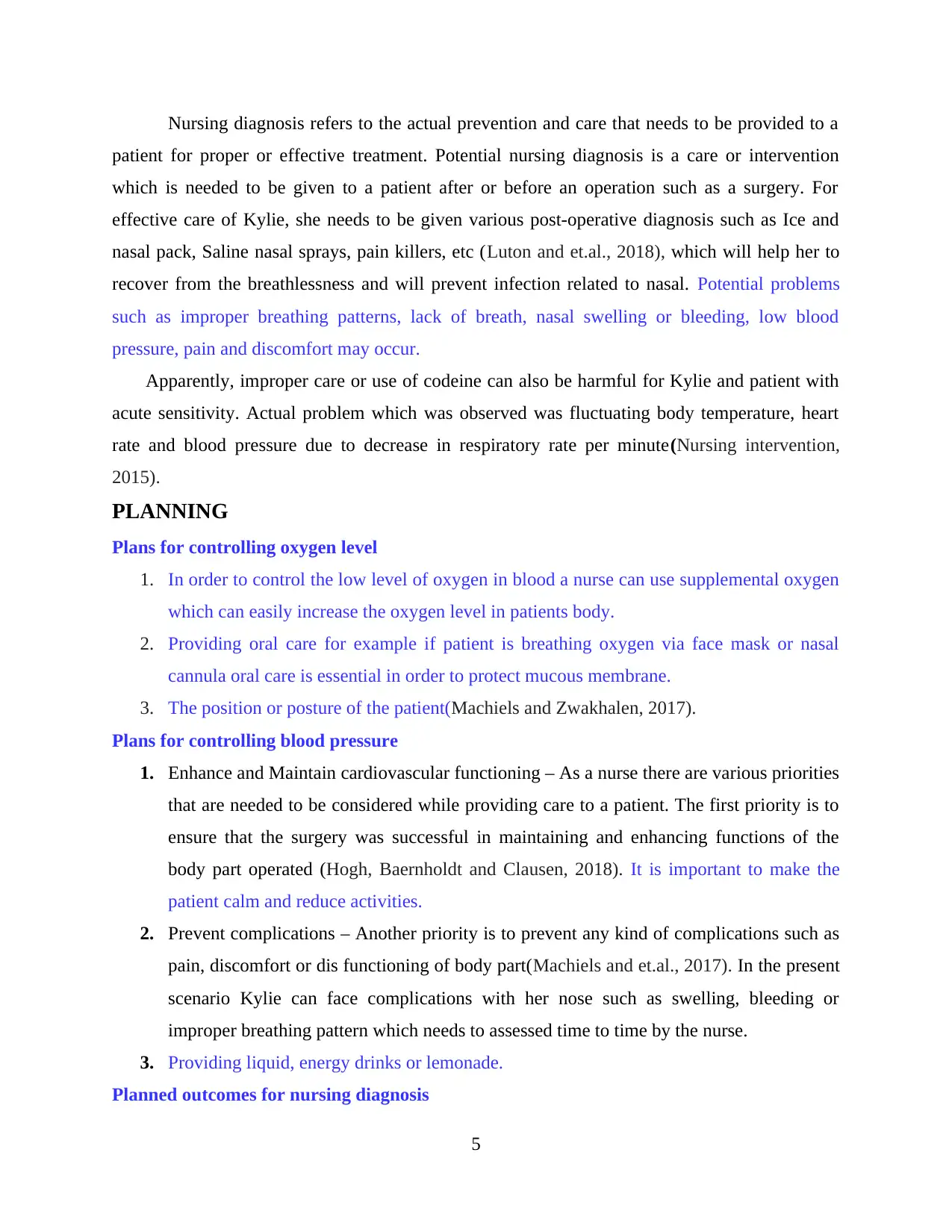
Nursing diagnosis refers to the actual prevention and care that needs to be provided to a
patient for proper or effective treatment. Potential nursing diagnosis is a care or intervention
which is needed to be given to a patient after or before an operation such as a surgery. For
effective care of Kylie, she needs to be given various post-operative diagnosis such as Ice and
nasal pack, Saline nasal sprays, pain killers, etc (Luton and et.al., 2018), which will help her to
recover from the breathlessness and will prevent infection related to nasal. Potential problems
such as improper breathing patterns, lack of breath, nasal swelling or bleeding, low blood
pressure, pain and discomfort may occur.
Apparently, improper care or use of codeine can also be harmful for Kylie and patient with
acute sensitivity. Actual problem which was observed was fluctuating body temperature, heart
rate and blood pressure due to decrease in respiratory rate per minute(Nursing intervention,
2015).
PLANNING
Plans for controlling oxygen level
1. In order to control the low level of oxygen in blood a nurse can use supplemental oxygen
which can easily increase the oxygen level in patients body.
2. Providing oral care for example if patient is breathing oxygen via face mask or nasal
cannula oral care is essential in order to protect mucous membrane.
3. The position or posture of the patient(Machiels and Zwakhalen, 2017).
Plans for controlling blood pressure
1. Enhance and Maintain cardiovascular functioning – As a nurse there are various priorities
that are needed to be considered while providing care to a patient. The first priority is to
ensure that the surgery was successful in maintaining and enhancing functions of the
body part operated (Hogh, Baernholdt and Clausen, 2018). It is important to make the
patient calm and reduce activities.
2. Prevent complications – Another priority is to prevent any kind of complications such as
pain, discomfort or dis functioning of body part(Machiels and et.al., 2017). In the present
scenario Kylie can face complications with her nose such as swelling, bleeding or
improper breathing pattern which needs to assessed time to time by the nurse.
3. Providing liquid, energy drinks or lemonade.
Planned outcomes for nursing diagnosis
5
patient for proper or effective treatment. Potential nursing diagnosis is a care or intervention
which is needed to be given to a patient after or before an operation such as a surgery. For
effective care of Kylie, she needs to be given various post-operative diagnosis such as Ice and
nasal pack, Saline nasal sprays, pain killers, etc (Luton and et.al., 2018), which will help her to
recover from the breathlessness and will prevent infection related to nasal. Potential problems
such as improper breathing patterns, lack of breath, nasal swelling or bleeding, low blood
pressure, pain and discomfort may occur.
Apparently, improper care or use of codeine can also be harmful for Kylie and patient with
acute sensitivity. Actual problem which was observed was fluctuating body temperature, heart
rate and blood pressure due to decrease in respiratory rate per minute(Nursing intervention,
2015).
PLANNING
Plans for controlling oxygen level
1. In order to control the low level of oxygen in blood a nurse can use supplemental oxygen
which can easily increase the oxygen level in patients body.
2. Providing oral care for example if patient is breathing oxygen via face mask or nasal
cannula oral care is essential in order to protect mucous membrane.
3. The position or posture of the patient(Machiels and Zwakhalen, 2017).
Plans for controlling blood pressure
1. Enhance and Maintain cardiovascular functioning – As a nurse there are various priorities
that are needed to be considered while providing care to a patient. The first priority is to
ensure that the surgery was successful in maintaining and enhancing functions of the
body part operated (Hogh, Baernholdt and Clausen, 2018). It is important to make the
patient calm and reduce activities.
2. Prevent complications – Another priority is to prevent any kind of complications such as
pain, discomfort or dis functioning of body part(Machiels and et.al., 2017). In the present
scenario Kylie can face complications with her nose such as swelling, bleeding or
improper breathing pattern which needs to assessed time to time by the nurse.
3. Providing liquid, energy drinks or lemonade.
Planned outcomes for nursing diagnosis
5
Paraphrase This Document
Need a fresh take? Get an instant paraphrase of this document with our AI Paraphraser
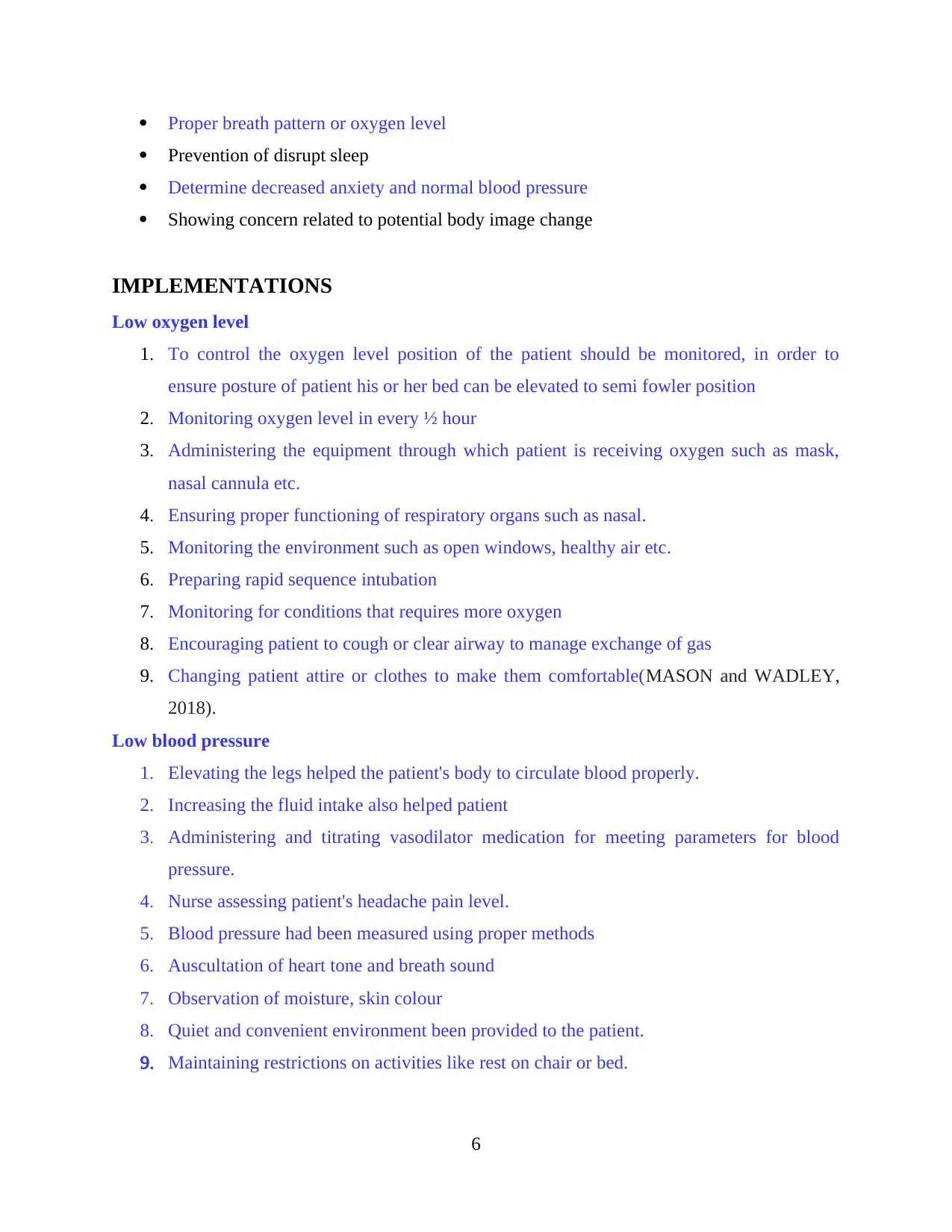
Proper breath pattern or oxygen level
Prevention of disrupt sleep
Determine decreased anxiety and normal blood pressure
Showing concern related to potential body image change
IMPLEMENTATIONS
Low oxygen level
1. To control the oxygen level position of the patient should be monitored, in order to
ensure posture of patient his or her bed can be elevated to semi fowler position
2. Monitoring oxygen level in every ½ hour
3. Administering the equipment through which patient is receiving oxygen such as mask,
nasal cannula etc.
4. Ensuring proper functioning of respiratory organs such as nasal.
5. Monitoring the environment such as open windows, healthy air etc.
6. Preparing rapid sequence intubation
7. Monitoring for conditions that requires more oxygen
8. Encouraging patient to cough or clear airway to manage exchange of gas
9. Changing patient attire or clothes to make them comfortable(MASON and WADLEY,
2018).
Low blood pressure
1. Elevating the legs helped the patient's body to circulate blood properly.
2. Increasing the fluid intake also helped patient
3. Administering and titrating vasodilator medication for meeting parameters for blood
pressure.
4. Nurse assessing patient's headache pain level.
5. Blood pressure had been measured using proper methods
6. Auscultation of heart tone and breath sound
7. Observation of moisture, skin colour
8. Quiet and convenient environment been provided to the patient.
9. Maintaining restrictions on activities like rest on chair or bed.
6
Prevention of disrupt sleep
Determine decreased anxiety and normal blood pressure
Showing concern related to potential body image change
IMPLEMENTATIONS
Low oxygen level
1. To control the oxygen level position of the patient should be monitored, in order to
ensure posture of patient his or her bed can be elevated to semi fowler position
2. Monitoring oxygen level in every ½ hour
3. Administering the equipment through which patient is receiving oxygen such as mask,
nasal cannula etc.
4. Ensuring proper functioning of respiratory organs such as nasal.
5. Monitoring the environment such as open windows, healthy air etc.
6. Preparing rapid sequence intubation
7. Monitoring for conditions that requires more oxygen
8. Encouraging patient to cough or clear airway to manage exchange of gas
9. Changing patient attire or clothes to make them comfortable(MASON and WADLEY,
2018).
Low blood pressure
1. Elevating the legs helped the patient's body to circulate blood properly.
2. Increasing the fluid intake also helped patient
3. Administering and titrating vasodilator medication for meeting parameters for blood
pressure.
4. Nurse assessing patient's headache pain level.
5. Blood pressure had been measured using proper methods
6. Auscultation of heart tone and breath sound
7. Observation of moisture, skin colour
8. Quiet and convenient environment been provided to the patient.
9. Maintaining restrictions on activities like rest on chair or bed.
6
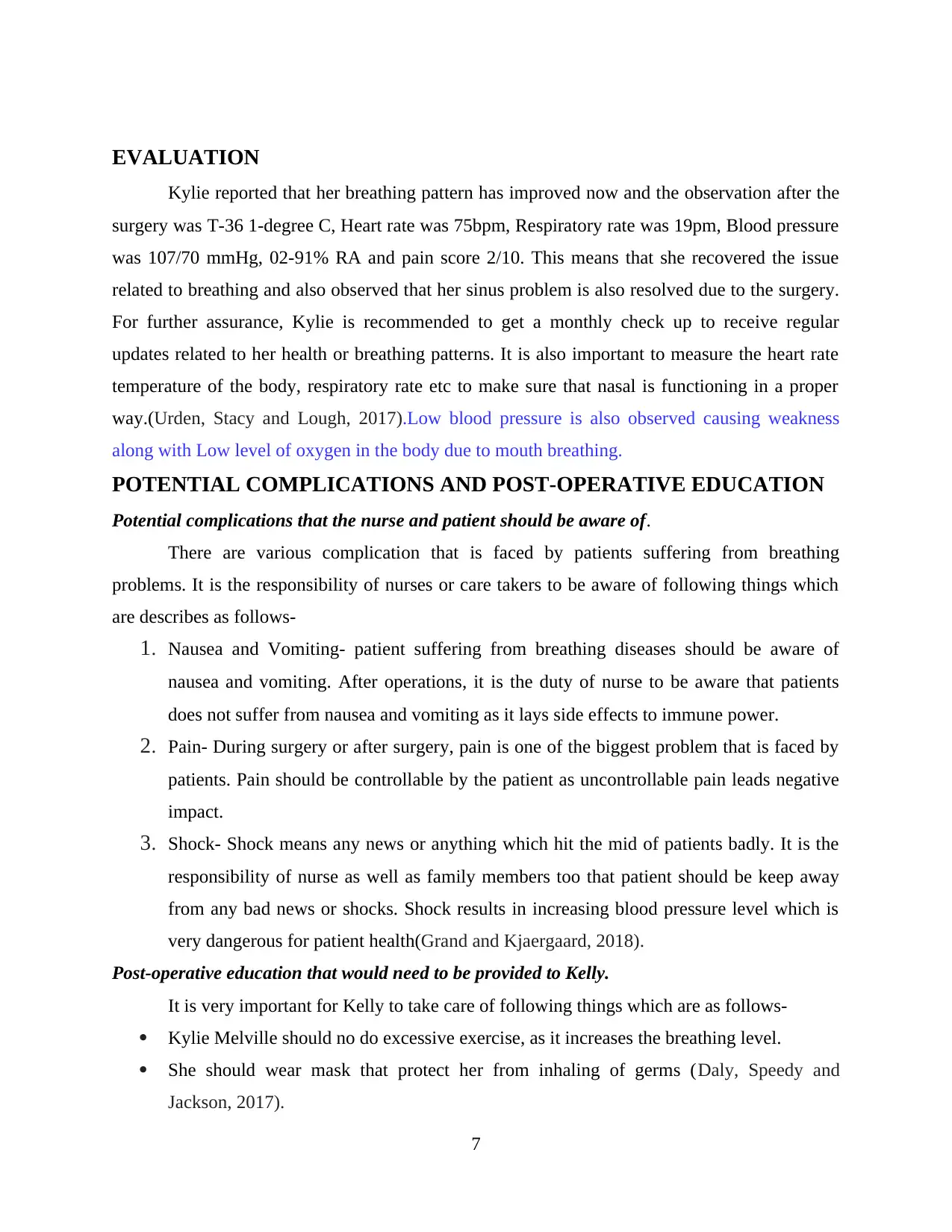
EVALUATION
Kylie reported that her breathing pattern has improved now and the observation after the
surgery was T-36 1-degree C, Heart rate was 75bpm, Respiratory rate was 19pm, Blood pressure
was 107/70 mmHg, 02-91% RA and pain score 2/10. This means that she recovered the issue
related to breathing and also observed that her sinus problem is also resolved due to the surgery.
For further assurance, Kylie is recommended to get a monthly check up to receive regular
updates related to her health or breathing patterns. It is also important to measure the heart rate
temperature of the body, respiratory rate etc to make sure that nasal is functioning in a proper
way.(Urden, Stacy and Lough, 2017).Low blood pressure is also observed causing weakness
along with Low level of oxygen in the body due to mouth breathing.
POTENTIAL COMPLICATIONS AND POST-OPERATIVE EDUCATION
Potential complications that the nurse and patient should be aware of.
There are various complication that is faced by patients suffering from breathing
problems. It is the responsibility of nurses or care takers to be aware of following things which
are describes as follows-
1. Nausea and Vomiting- patient suffering from breathing diseases should be aware of
nausea and vomiting. After operations, it is the duty of nurse to be aware that patients
does not suffer from nausea and vomiting as it lays side effects to immune power.
2. Pain- During surgery or after surgery, pain is one of the biggest problem that is faced by
patients. Pain should be controllable by the patient as uncontrollable pain leads negative
impact.
3. Shock- Shock means any news or anything which hit the mid of patients badly. It is the
responsibility of nurse as well as family members too that patient should be keep away
from any bad news or shocks. Shock results in increasing blood pressure level which is
very dangerous for patient health(Grand and Kjaergaard, 2018).
Post-operative education that would need to be provided to Kelly.
It is very important for Kelly to take care of following things which are as follows-
Kylie Melville should no do excessive exercise, as it increases the breathing level.
She should wear mask that protect her from inhaling of germs (Daly, Speedy and
Jackson, 2017).
7
Kylie reported that her breathing pattern has improved now and the observation after the
surgery was T-36 1-degree C, Heart rate was 75bpm, Respiratory rate was 19pm, Blood pressure
was 107/70 mmHg, 02-91% RA and pain score 2/10. This means that she recovered the issue
related to breathing and also observed that her sinus problem is also resolved due to the surgery.
For further assurance, Kylie is recommended to get a monthly check up to receive regular
updates related to her health or breathing patterns. It is also important to measure the heart rate
temperature of the body, respiratory rate etc to make sure that nasal is functioning in a proper
way.(Urden, Stacy and Lough, 2017).Low blood pressure is also observed causing weakness
along with Low level of oxygen in the body due to mouth breathing.
POTENTIAL COMPLICATIONS AND POST-OPERATIVE EDUCATION
Potential complications that the nurse and patient should be aware of.
There are various complication that is faced by patients suffering from breathing
problems. It is the responsibility of nurses or care takers to be aware of following things which
are describes as follows-
1. Nausea and Vomiting- patient suffering from breathing diseases should be aware of
nausea and vomiting. After operations, it is the duty of nurse to be aware that patients
does not suffer from nausea and vomiting as it lays side effects to immune power.
2. Pain- During surgery or after surgery, pain is one of the biggest problem that is faced by
patients. Pain should be controllable by the patient as uncontrollable pain leads negative
impact.
3. Shock- Shock means any news or anything which hit the mid of patients badly. It is the
responsibility of nurse as well as family members too that patient should be keep away
from any bad news or shocks. Shock results in increasing blood pressure level which is
very dangerous for patient health(Grand and Kjaergaard, 2018).
Post-operative education that would need to be provided to Kelly.
It is very important for Kelly to take care of following things which are as follows-
Kylie Melville should no do excessive exercise, as it increases the breathing level.
She should wear mask that protect her from inhaling of germs (Daly, Speedy and
Jackson, 2017).
7
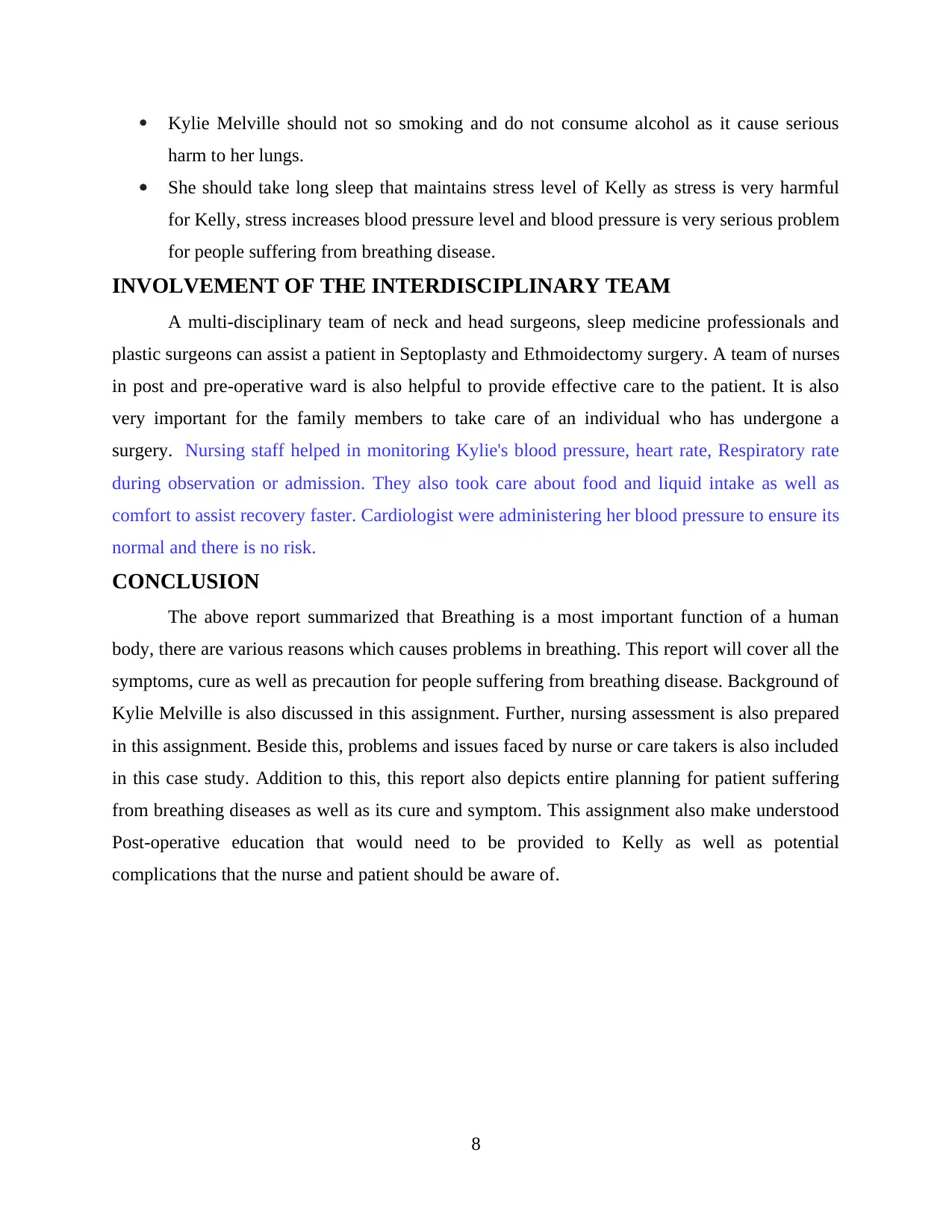
Kylie Melville should not so smoking and do not consume alcohol as it cause serious
harm to her lungs.
She should take long sleep that maintains stress level of Kelly as stress is very harmful
for Kelly, stress increases blood pressure level and blood pressure is very serious problem
for people suffering from breathing disease.
INVOLVEMENT OF THE INTERDISCIPLINARY TEAM
A multi-disciplinary team of neck and head surgeons, sleep medicine professionals and
plastic surgeons can assist a patient in Septoplasty and Ethmoidectomy surgery. A team of nurses
in post and pre-operative ward is also helpful to provide effective care to the patient. It is also
very important for the family members to take care of an individual who has undergone a
surgery. Nursing staff helped in monitoring Kylie's blood pressure, heart rate, Respiratory rate
during observation or admission. They also took care about food and liquid intake as well as
comfort to assist recovery faster. Cardiologist were administering her blood pressure to ensure its
normal and there is no risk.
CONCLUSION
The above report summarized that Breathing is a most important function of a human
body, there are various reasons which causes problems in breathing. This report will cover all the
symptoms, cure as well as precaution for people suffering from breathing disease. Background of
Kylie Melville is also discussed in this assignment. Further, nursing assessment is also prepared
in this assignment. Beside this, problems and issues faced by nurse or care takers is also included
in this case study. Addition to this, this report also depicts entire planning for patient suffering
from breathing diseases as well as its cure and symptom. This assignment also make understood
Post-operative education that would need to be provided to Kelly as well as potential
complications that the nurse and patient should be aware of.
8
harm to her lungs.
She should take long sleep that maintains stress level of Kelly as stress is very harmful
for Kelly, stress increases blood pressure level and blood pressure is very serious problem
for people suffering from breathing disease.
INVOLVEMENT OF THE INTERDISCIPLINARY TEAM
A multi-disciplinary team of neck and head surgeons, sleep medicine professionals and
plastic surgeons can assist a patient in Septoplasty and Ethmoidectomy surgery. A team of nurses
in post and pre-operative ward is also helpful to provide effective care to the patient. It is also
very important for the family members to take care of an individual who has undergone a
surgery. Nursing staff helped in monitoring Kylie's blood pressure, heart rate, Respiratory rate
during observation or admission. They also took care about food and liquid intake as well as
comfort to assist recovery faster. Cardiologist were administering her blood pressure to ensure its
normal and there is no risk.
CONCLUSION
The above report summarized that Breathing is a most important function of a human
body, there are various reasons which causes problems in breathing. This report will cover all the
symptoms, cure as well as precaution for people suffering from breathing disease. Background of
Kylie Melville is also discussed in this assignment. Further, nursing assessment is also prepared
in this assignment. Beside this, problems and issues faced by nurse or care takers is also included
in this case study. Addition to this, this report also depicts entire planning for patient suffering
from breathing diseases as well as its cure and symptom. This assignment also make understood
Post-operative education that would need to be provided to Kelly as well as potential
complications that the nurse and patient should be aware of.
8
Secure Best Marks with AI Grader
Need help grading? Try our AI Grader for instant feedback on your assignments.
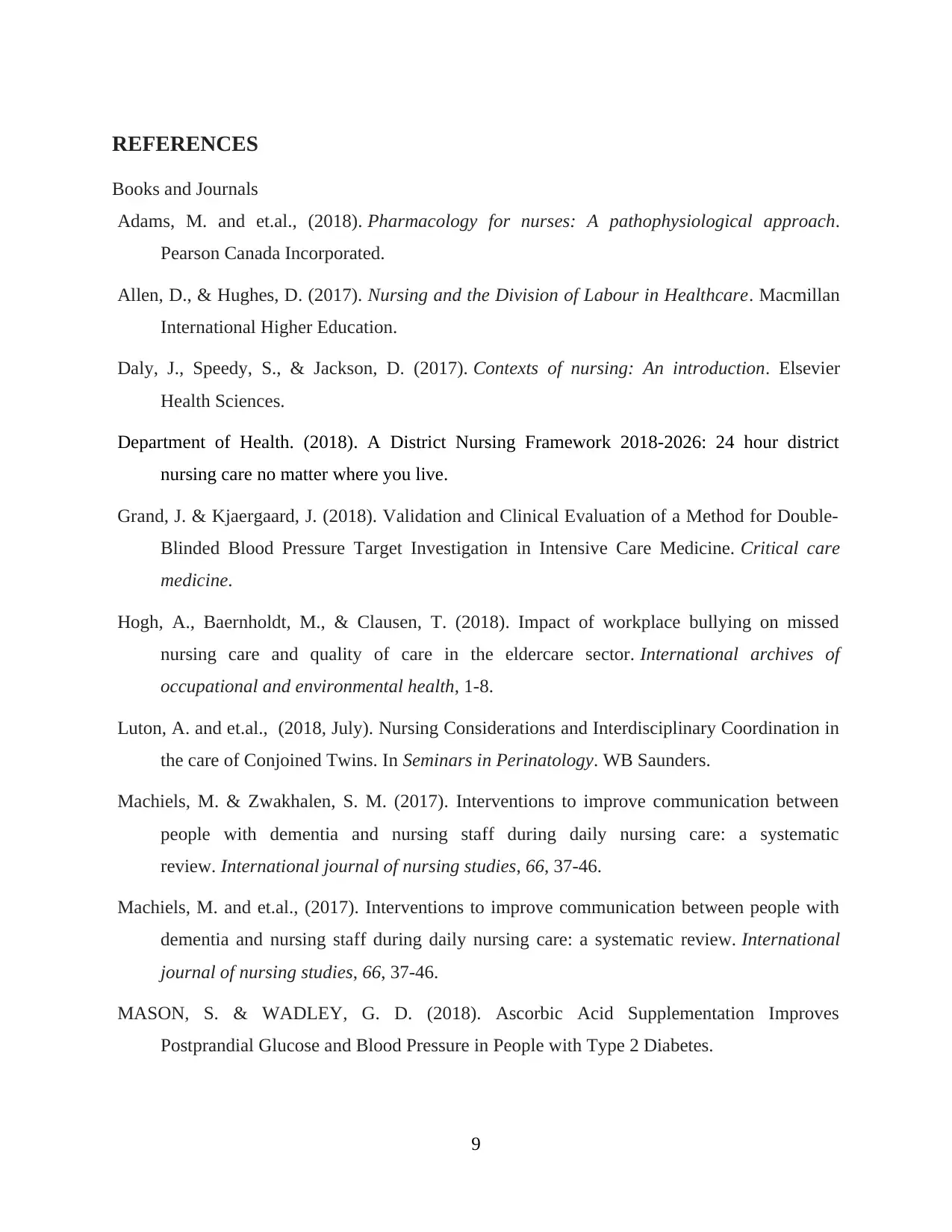
REFERENCES
Books and Journals
Adams, M. and et.al., (2018). Pharmacology for nurses: A pathophysiological approach.
Pearson Canada Incorporated.
Allen, D., & Hughes, D. (2017). Nursing and the Division of Labour in Healthcare. Macmillan
International Higher Education.
Daly, J., Speedy, S., & Jackson, D. (2017). Contexts of nursing: An introduction. Elsevier
Health Sciences.
Department of Health. (2018). A District Nursing Framework 2018-2026: 24 hour district
nursing care no matter where you live.
Grand, J. & Kjaergaard, J. (2018). Validation and Clinical Evaluation of a Method for Double-
Blinded Blood Pressure Target Investigation in Intensive Care Medicine. Critical care
medicine.
Hogh, A., Baernholdt, M., & Clausen, T. (2018). Impact of workplace bullying on missed
nursing care and quality of care in the eldercare sector. International archives of
occupational and environmental health, 1-8.
Luton, A. and et.al., (2018, July). Nursing Considerations and Interdisciplinary Coordination in
the care of Conjoined Twins. In Seminars in Perinatology. WB Saunders.
Machiels, M. & Zwakhalen, S. M. (2017). Interventions to improve communication between
people with dementia and nursing staff during daily nursing care: a systematic
review. International journal of nursing studies, 66, 37-46.
Machiels, M. and et.al., (2017). Interventions to improve communication between people with
dementia and nursing staff during daily nursing care: a systematic review. International
journal of nursing studies, 66, 37-46.
MASON, S. & WADLEY, G. D. (2018). Ascorbic Acid Supplementation Improves
Postprandial Glucose and Blood Pressure in People with Type 2 Diabetes.
9
Books and Journals
Adams, M. and et.al., (2018). Pharmacology for nurses: A pathophysiological approach.
Pearson Canada Incorporated.
Allen, D., & Hughes, D. (2017). Nursing and the Division of Labour in Healthcare. Macmillan
International Higher Education.
Daly, J., Speedy, S., & Jackson, D. (2017). Contexts of nursing: An introduction. Elsevier
Health Sciences.
Department of Health. (2018). A District Nursing Framework 2018-2026: 24 hour district
nursing care no matter where you live.
Grand, J. & Kjaergaard, J. (2018). Validation and Clinical Evaluation of a Method for Double-
Blinded Blood Pressure Target Investigation in Intensive Care Medicine. Critical care
medicine.
Hogh, A., Baernholdt, M., & Clausen, T. (2018). Impact of workplace bullying on missed
nursing care and quality of care in the eldercare sector. International archives of
occupational and environmental health, 1-8.
Luton, A. and et.al., (2018, July). Nursing Considerations and Interdisciplinary Coordination in
the care of Conjoined Twins. In Seminars in Perinatology. WB Saunders.
Machiels, M. & Zwakhalen, S. M. (2017). Interventions to improve communication between
people with dementia and nursing staff during daily nursing care: a systematic
review. International journal of nursing studies, 66, 37-46.
Machiels, M. and et.al., (2017). Interventions to improve communication between people with
dementia and nursing staff during daily nursing care: a systematic review. International
journal of nursing studies, 66, 37-46.
MASON, S. & WADLEY, G. D. (2018). Ascorbic Acid Supplementation Improves
Postprandial Glucose and Blood Pressure in People with Type 2 Diabetes.
9
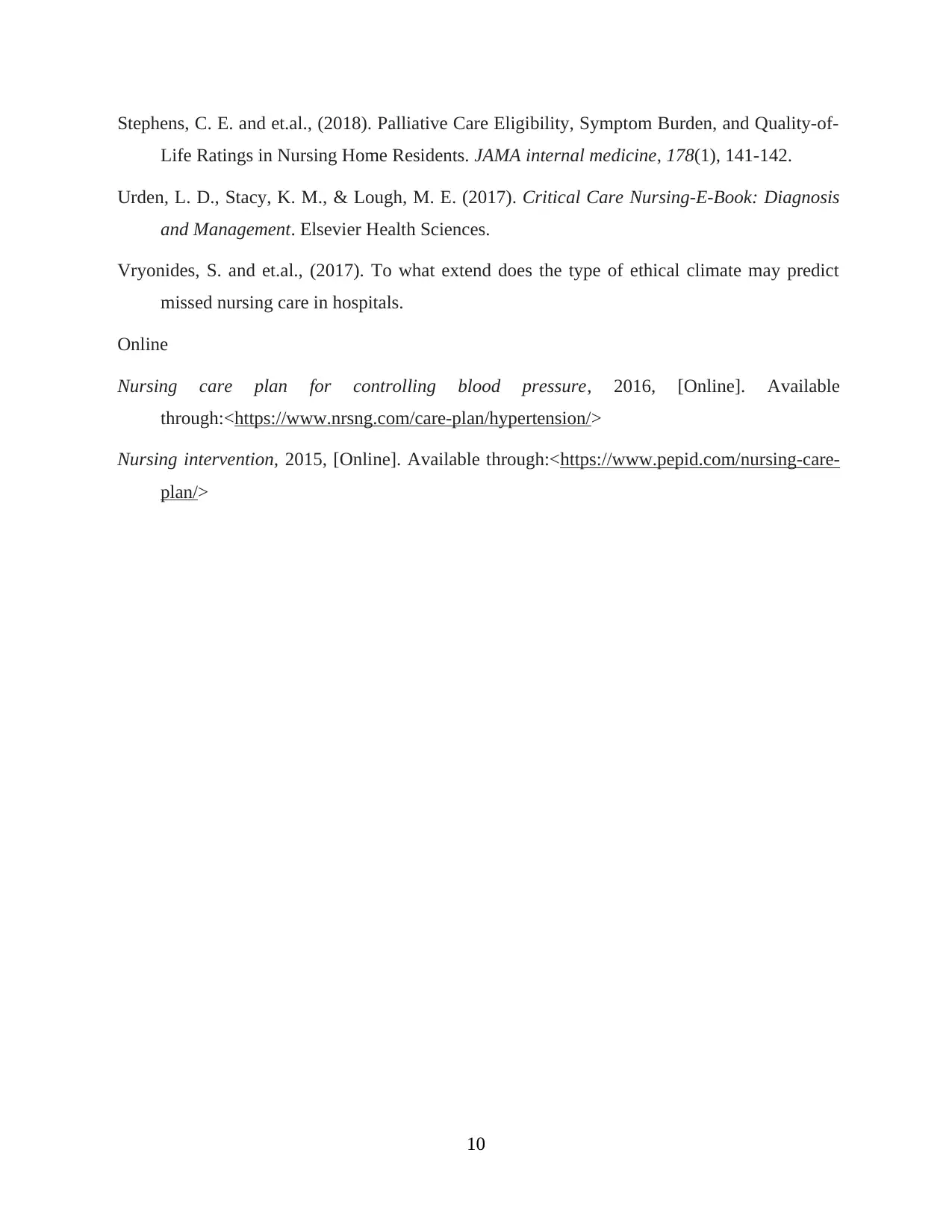
Stephens, C. E. and et.al., (2018). Palliative Care Eligibility, Symptom Burden, and Quality-of-
Life Ratings in Nursing Home Residents. JAMA internal medicine, 178(1), 141-142.
Urden, L. D., Stacy, K. M., & Lough, M. E. (2017). Critical Care Nursing-E-Book: Diagnosis
and Management. Elsevier Health Sciences.
Vryonides, S. and et.al., (2017). To what extend does the type of ethical climate may predict
missed nursing care in hospitals.
Online
Nursing care plan for controlling blood pressure, 2016, [Online]. Available
through:<https://www.nrsng.com/care-plan/hypertension/>
Nursing intervention, 2015, [Online]. Available through:<https://www.pepid.com/nursing-care-
plan/>
10
Life Ratings in Nursing Home Residents. JAMA internal medicine, 178(1), 141-142.
Urden, L. D., Stacy, K. M., & Lough, M. E. (2017). Critical Care Nursing-E-Book: Diagnosis
and Management. Elsevier Health Sciences.
Vryonides, S. and et.al., (2017). To what extend does the type of ethical climate may predict
missed nursing care in hospitals.
Online
Nursing care plan for controlling blood pressure, 2016, [Online]. Available
through:<https://www.nrsng.com/care-plan/hypertension/>
Nursing intervention, 2015, [Online]. Available through:<https://www.pepid.com/nursing-care-
plan/>
10
1 out of 12
Your All-in-One AI-Powered Toolkit for Academic Success.
+13062052269
info@desklib.com
Available 24*7 on WhatsApp / Email
![[object Object]](/_next/static/media/star-bottom.7253800d.svg)
Unlock your academic potential
© 2024 | Zucol Services PVT LTD | All rights reserved.

